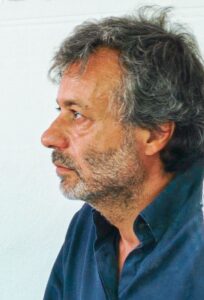TRANSDISCIPLINARITY IS THE CONTEMPORARY FORMAT OF THE PERFORMATIVE PRACTICE BY SERGIO MARIO ILLUMINATO

Throughout an eclectic artistic journey, I have processed, under the banner of hybridity, the fragile condition of human reality. The practice of painting and sculpture, in particular, has revealed physical and mental territories beyond conventional boundaries, allowing me to unlearn, re-understand the emotions, choices, and tensions that characterize perception and behavior in everyday life.
From these experimental and observational findings, I made a valuable discovery: the fusion of vulnerability and the body, rooted in the history of human societies over millennia, yet the digital revolution with the still unwritten chapter on artificial intelligence and the metaverse has reaffirmed its fundamental anthropological structure even in the contemporary era of the infosphere, as defined by philosopher Luciano Floridi. This reflection has marked not only the formal and aesthetic perspective but has also had a profound impact on me philosophically, ethically, and politically.
Another but convergent aspect. International contemporary art exhibitions are increasingly using art as an abstract entity separated from reality. Art seems to be confined more and more to ideologically coded spaces like museums, fairs, and galleries. Claudio Parmiggiani, among artists with an international voice, raised an interesting question: What can be built in art today, starting from the offensive, fashionable, and festive optimism of an art world that, while everything is burning, points us to Disneyland as a perspective?
Personally, in response to the current dramatic situation, I felt the need to react artistically by escaping the predetermined anesthetic spaces that relegate art to the margins and tried to bring into the world, as Alighiero Boetti affirmed. I work to rehabilitate the “contemporary cathedrals of vulnerability,” including former prisons, hospitals, slaughterhouses, barracks, churches, factories, schools… and other places in a state of severe abandonment. My research in these spaces aims to create a potential experiential environment, a meditative space characterized by crystalline transparency, in order to recover a ritual dimension open to the other, in which artists and participants can immerse themselves to listen to the vibrations of pre-existing elements along with the sensitivity and energy of the Communicative Artistic Organisms (CAO) that I have developed over the years. Exhibition spaces become places where an unparalleled process of relationships unfolds, revealing a shared lexicon.
I named these devices Communicative Artistic Organisms because they have no fixed and finished form but are composed of an ever-evolving “Cosmic-Weave-Fabric” where everything is in a state of change: chemical reactions, fermentations, chromatic alterations, and decay. This name reinforces the idea that art is a process closely linked to life as raw material and involves an active and inclusive interpretive nature between artists and participants.
From these and many other experimental and observational experiences, the BOOK entitled “Corpus et Vulnus: homage to the masters Tàpies, Kiefer, Parmiggiani” was born. The ideas presented in the book were then transformed into creative works during a unique and unrepeatable ARTISTIC RESIDENCY that we organized at the former Pontifical Prison of Velletri, a space of over a thousand square meters built in 1861 by the Romani family. During the six months of residency, I collaborated with a group of students and painting and sculpture technicians from the Academy of Fine Arts in Rome, as well as teachers and professionals in cinema, dance, music, and photography. Together, we explored this space, which had been in a state of hibernation for about thirty years.
We dedicated these months to create a deep, articulated, critical, fragile, and necessary “intellectual space.” Through unusual perspectives guided by the concept of transdisciplinarity, we practiced an inclusive and open relational life in which it was possible to explore and unveil the nature of the multiple connections between isolated issues, in a space where questions are revisited, alternatives reconsidered, and interrelationships revealed (UNESCO – Division of Philosophy and Ethics, 1998).
The final result was the birth of the VulnerarTe MOVEMENT, the creation of the SHORT FILM “Vulnerare,” and the TRANSDISCIPLINARY PERFORMATIVE PRACTICE “iosonovulnerabile.” These interconnected activities encapsulate the essence of an immersive site-coexistence experience, which we are presenting to students and the public at the former Pontifical Prison of Velletri.
But there’s more. The structure that hosted us was owned by the State for many years. Today, it is one of the seven million abandoned buildings in Italy. Several proposals have been made for its conversion for various purposes, such as apartments or a shopping center. We don’t know many details about its bureaucratic history, but the question of how to requalify it has troubled the last three municipal administrations, eager to recover the building in a useful way. Thanks to an expenditure of 1.3 million euros, the former prison has been preserved from any real estate speculation and is now owned by the Municipality of Velletri.
For one of the many accidental synchronicities that mark our path, the project presented in these pages represents the last experience and living testimony of the building in the state in which it has come to our attention, preserving the memory and original traces of its two-century history. The book, the artistic residency, the short film, the transdisciplinary performative practice, and the photographic shots of the entire residency process, along with the testimonials of the protagonists, constitute the final documentation before the architectural renovation and the change of destination and use of the nineteenth-century structure, expected in the coming months.
